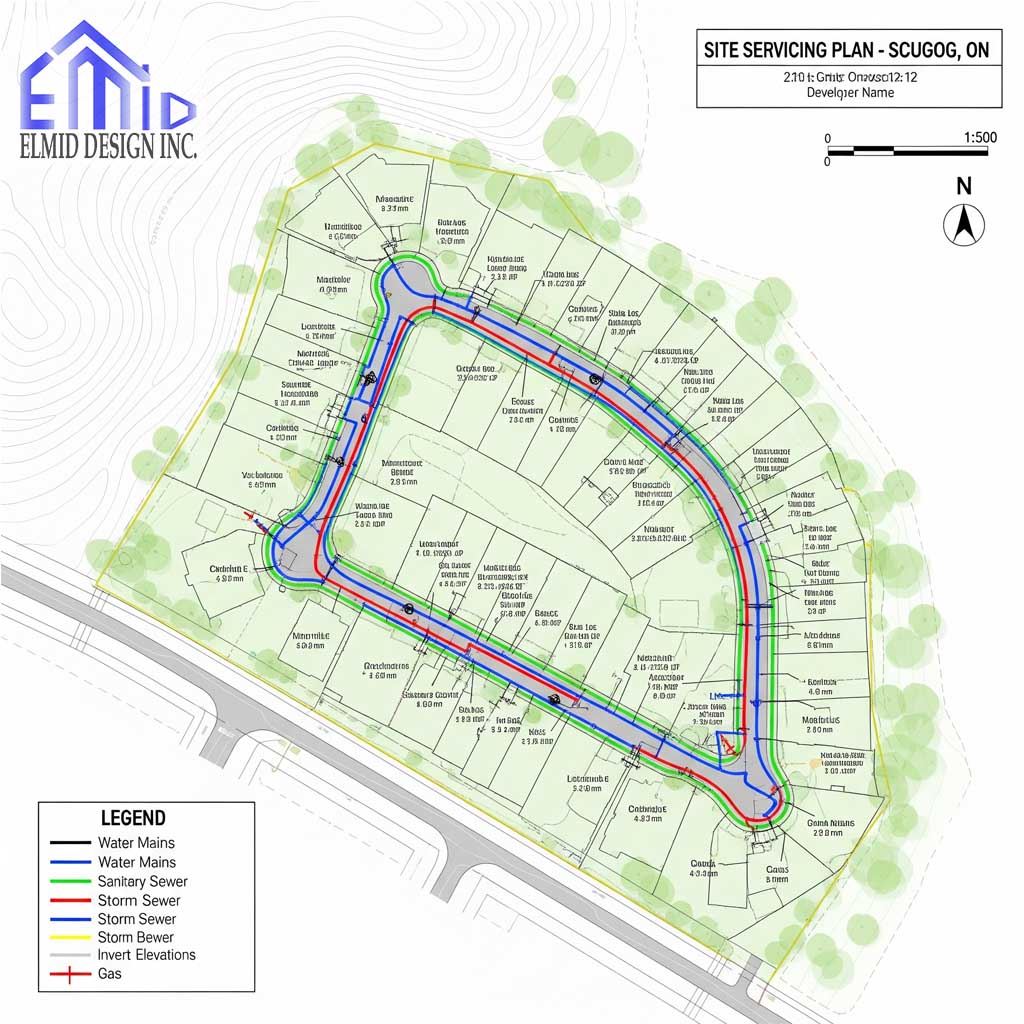A site servicing plan in Scugog is one of the most important steps in moving from an empty lot to a completed building. Whether you are preparing a commercial plaza, an industrial facility, or a residential development, the servicing plan shows exactly how your property will connect to essential infrastructure such as water, sewer, and stormwater systems. Without this approval, your building permit will not move forward. That is why anyone planning a project in Scugog needs to understand what a servicing plan includes, how it fits into the local approval process, and why it protects your investment.
Key Takeaways
A site servicing plan in Scugog is required for almost every building project.
It demonstrates how a property will be connected to municipal water, sanitary, and stormwater systems.
The plan also covers grading, drainage, and erosion controls during and after construction.
Approval is necessary before building permits can be issued.
Working with licensed engineers such as Elmid Design Inc, which holds a Certificate of Authorization from Professional Engineers Ontario, ensures compliance and faster approvals.
Why a Site Servicing Plan in Scugog Matters
A site servicing plan is not just a drawing. It is the technical roadmap that shows how a new building will fit into the Township’s infrastructure. In Scugog, building without this step is not possible. Municipal staff, conservation authorities, and the Region of Durham all rely on the plan to confirm that your project will not overload existing systems. They also use it to verify that drainage and stormwater controls will protect nearby properties and the environment. For builders, the plan reduces the risk of delays, costly changes, and conflicts with neighbors.
When You Need a Site Servicing Plan in Scugog
Any property owner who is planning a new commercial, industrial, institutional, or multi-residential building must prepare a servicing plan. Even small projects, such as redeveloping an existing site or adding major expansions, usually trigger this requirement. The Township of Scugog reviews the plan as part of the site plan approval process, which comes before a building permit can be issued. If your project is located within a subdivision, the servicing plan is also part of the subdivision agreement. This means you cannot move forward until municipal staff confirm that the servicing design meets all standards.
What a Site Servicing Plan Includes
A complete servicing plan contains more than one drawing. It typically includes several sheets showing underground services, grading, and stormwater management features. Engineers prepare profiles of watermains, sewers, and storm pipes to confirm slope and capacity. Tables are added with pipe sizes, materials, and invert elevations. Plans also show how surface water will drain across the site, including swales, catch basins, and overland flow routes. Erosion and sediment controls for construction are outlined as well. Together, these details give reviewers confidence that the proposed building can operate safely without causing infrastructure or flooding problems.
Local Requirements for Scugog Servicing Plans
Each municipality has its own rules for servicing plans, and Scugog is no different. The Township requires engineers to follow its design criteria and standard drawings. These criteria define the size, spacing, and material for sewers, watermains, and catch basins. The Region of Durham must also approve connections to regional systems, such as trunk sewers and watermains. Kawartha Conservation may review stormwater details to protect nearby lakes and wetlands. In addition, developers must show that phosphorus levels in stormwater runoff will not exceed pre-development conditions. This requirement helps protect Lake Scugog and its sensitive ecosystem.
The Role of Stormwater Management
Stormwater management is one of the most detailed parts of a servicing plan in Scugog. Every property produces runoff when rain or snowmelt flows off rooftops, parking lots, and driveways. If this water is not controlled, it can flood streets, erode soils, and pollute lakes. Engineers calculate flows for both frequent storms and rare, intense storms. They design pipes, ponds, and overland routes to carry the water safely. Low impact development measures, such as infiltration trenches or rain gardens, may also be included. These features improve water quality and reduce peak flows, which is critical for compliance in Scugog’s watershed areas.
Grading and Drainage Considerations
Proper grading is essential for every building site. In Scugog, the servicing plan shows how ground elevations will change across the property. Engineers design grading so water drains away from buildings and toward approved outlets. The plan must clearly show overland flow routes that carry water during major storm events. Lot drainage plays a critical role in subdivisions because one poorly graded lot can cause problems for multiple neighbors. Engineers often add retaining walls, swales, and culverts to control flow. Municipal staff will not accept the servicing design unless the grading plan meets approval.
Water and Sanitary Servicing in Scugog
Connecting to water and sanitary services forms a critical part of the plan. Engineers design the location, depth, and slope of pipes to tie into municipal systems. They include fire hydrants and domestic water services to ensure both safety and daily supply. They also design sanitary sewers with the proper slope so wastewater flows by gravity. When gravity flow is not possible, engineers add a pumping station to maintain service. The Township and Region carefully review these designs because undersized or poorly aligned services can cause backups and failures. For developers, this step ensures long term reliability.
Approvals and Review Process
After preparing the drawings, the applicant submits the servicing plan with the site plan application. The Township of Scugog reviews the plan along with the Region of Durham and conservation authorities. Reviewers provide comments, and the applicant revises the plan until it meets all standards. Once reviewers grant final approval, the developer signs a development agreement. This agreement authorizes the construction of servicing works and connections to municipal systems. The Township issues a building permit only after granting approval. That is why builders must work with a licensed engineering firm that understands the local process.
Why Work with Professional Engineers
Preparing a site servicing plan is not a task for unlicensed consultants. The Township requires that all plans be sealed by a Professional Engineer licensed in Ontario. This ensures that designs meet provincial and municipal standards. Firms such as Elmid Design Inc, which holds a Certificate of Authorization from Professional Engineers Ontario, bring both expertise and accountability. Their work provides municipalities with confidence that the project will be safe, functional, and durable. For property owners, hiring a qualified firm reduces delays, prevents costly redesigns, and speeds up approval timelines. It also builds trust with reviewers and contractors.
Risks of Skipping or Rushing the Process
Some property owners try to minimize servicing design, but this often leads to major setbacks. Without a proper plan, the Township may refuse to issue approvals, halting construction. Even if initial approvals are granted, poor servicing can create flooding, sewer backups, or safety issues that require costly fixes. Contractors may struggle with unclear designs, leading to disputes or delays. Insurance and liability risks also increase if problems occur. In Scugog, skipping steps will only waste time and money. A properly prepared servicing plan is always the smarter investment.

How a Site Servicing Plan in Scugog is Prepared
The preparation begins with a detailed land survey that captures existing grades, property boundaries, and underground services. From there, engineers design proposed water, sewer, and stormwater systems that connect the site to municipal networks. Engineers place each pipe, manhole, and catch basin with precise measurements to ensure long term functionality. They adjust grading and drainage patterns to carry surface water safely away from buildings. After completing the drawings, engineers attach calculations for flow, slope, and capacity as supporting documentation.
The Role of Functional Servicing Reports
In Scugog, larger developments often require a functional servicing report in addition to drawings. This report explains how the proposed systems will perform and how they connect to regional infrastructure. It includes hydraulic modeling of sewers, water pressure analysis, and stormwater runoff simulations. The report also demonstrates compliance with environmental standards such as phosphorus reduction. By reviewing both the drawings and the report, municipal staff can confirm that the design will function properly once built. Builders who skip this step face significant delays since reviewers will not proceed without it.
Approvals from the Township and Region
The Township of Scugog is the first reviewer of a servicing plan, but final approvals usually involve several agencies. The Region of Durham must sign off on water and sanitary sewer connections since they operate the larger systems. Kawartha Conservation may review stormwater management to protect Lake Scugog and surrounding wetlands. In some cases, the Ministry of the Environment or utility providers may also be involved. Builders must prepare for multiple rounds of comments. Only after every agency is satisfied will a development agreement be issued to allow construction to begin.
Costs Involved in a Site Servicing Plan
The cost of preparing and implementing a servicing plan in Scugog depends on the size and complexity of the project. Engineering fees cover surveys, drawings, and calculations. The Township and Region charge application fees for their review process. Construction costs for installing sewers, watermains, catch basins, and grading often represent the largest expense. Developers also provide financial securities to the Township to guarantee they will complete the servicing works. While the costs may seem high, they remain necessary to protect both the property owner and the surrounding community.
Timelines for Approval and Construction
The timeline for approval of a servicing plan in Scugog varies depending on the complexity of the project and the number of agencies involved. A straightforward commercial project may receive approval within a few months, while large subdivisions may take a year or more. The construction of servicing works also adds several months to the project schedule. Builders must allow time for inspections, revisions, and the preparation of as built drawings. Planning ahead and submitting a complete application with accurate designs can significantly reduce delays in the approval process.
Common Challenges in Scugog Servicing Plans
Builders in Scugog face several recurring challenges when preparing servicing plans. Limited capacity in existing sewer or water systems can prevent a project from moving forward until upgrades are completed. Stormwater management requirements are strict because of the sensitivity of Lake Scugog and surrounding wetlands. Topography and soil conditions can complicate grading and drainage designs. Coordination with multiple agencies often introduces delays if requirements are not met the first time. Working with experienced engineers helps to anticipate these challenges and design solutions before they become major obstacles.
Benefits of Proper Servicing Design
Although the process can feel overwhelming, a properly designed site servicing plan in Scugog provides lasting benefits. It ensures that a building will operate safely with reliable water, sewer, and drainage systems, it protects neighboring properties from flooding and environmental impacts. It also creates confidence among municipal staff, utility providers, and lenders that the project is well planned. For builders, this confidence translates into smoother approvals, fewer construction disputes, and lower long term maintenance costs. A strong servicing design is a foundation for project success.
Importance of Professional Oversight
Professional oversight is critical throughout the entire servicing process. Only a licensed Professional Engineer can prepare and seal the drawings required by the Township of Scugog. Firms such as Elmid Design Inc, which is authorized by Professional Engineers Ontario, bring credibility and accountability to every project. Their expertise not only ensures technical accuracy but also builds trust with municipal reviewers. This oversight reduces the risk of costly mistakes and helps builders avoid unnecessary delays. Choosing qualified professionals is an investment in both compliance and long term project success.
Who Approves a Site Servicing Plan in Scugog
Approval does not come from a single department. The Township of Scugog reviews the overall design, while the Region of Durham oversees water and sanitary servicing. Kawartha Conservation evaluates stormwater management to protect sensitive areas such as Lake Scugog. Utility providers may also comment on conflicts with hydro, gas, or communication lines. Only after all parties are satisfied can the Township issue a development agreement. Without this agreement, the building permit process will not continue.
How Long Does the Approval Process Take
Timelines vary depending on the scale of the project and the number of agencies involved. A small commercial property might move through review within three to four months if designs are complete and accurate. Larger residential subdivisions can require a year or more to finalize because of added complexity and environmental studies. Builders should plan for revisions since comments from the Township or Region usually require adjustments. Preparing complete and accurate submissions from the start is the best way to shorten the process.
What Happens During Construction
Once the Township approves the servicing plan, engineers and municipal inspectors supervise the start of construction. Contractors install watermains, sewers, and storm systems according to the approved drawings. Engineers shape grading to direct runoff properly and confirm that erosion controls stay in place before excavation begins and throughout construction. If field conditions change, engineers prepare updated drawings and resubmit them for review. When contractors complete construction, they provide as built surveys to confirm that the works match the design, and the Township reviews them for acceptance.
Why Inspections Are Critical
Inspections protect both the builder and the municipality. Township inspectors verify that installations follow design standards and function as intended. Engineers provide certifications to confirm compliance with professional practice and municipal requirements. Without these inspections, the Township will not accept the servicing works, and occupancy permits will be delayed. Inspections also help detect construction errors early, which reduces costly repairs later. Builders who try to bypass inspections risk significant setbacks in both approvals and project schedules.
How Much Does a Site Servicing Plan Cost
The cost depends on project size, site conditions, and complexity. Engineering fees cover surveys, design, and calculations, while the Township and Region charge municipal review fees. Construction costs for pipes, grading, and stormwater features usually make up the largest expense. Developers also post financial securities with the Township to guarantee they will complete the servicing works. These costs may seem high, but they protect property owners because they ensure the site meets safe and durable standards. Investing in proper servicing design ultimately saves money over time.
Can Small Projects Avoid a Servicing Plan
Some property owners believe small projects do not require a servicing plan. In Scugog, even modest commercial or multi-unit residential projects usually need servicing approval. Only minor renovations that do not alter drainage, water supply, or sanitary flows may be exempt. Any project that adds new buildings, parking areas, or major site changes almost always requires a servicing plan. Builders should consult municipal staff early to confirm requirements. Assuming a project is exempt often leads to costly surprises when applications are refused.
What Are the Environmental Considerations
Scugog places strong emphasis on protecting natural resources, especially Lake Scugog and its connected wetlands. Servicing plans must demonstrate that stormwater runoff will not increase phosphorus levels, which contribute to algae blooms and poor water quality. Engineers must also consider erosion, sediment control, and groundwater impacts. Low impact development features such as infiltration trenches or bioretention areas may be required. These environmental considerations protect the community while ensuring the development is sustainable. Builders who ignore these requirements face delays and additional costs for redesign.
Why Work with Licensed Engineering Firms
Working with licensed engineering firms such as Elmid Design Inc, which holds a Certificate of Authorization from Professional Engineers Ontario, ensures compliance with municipal and provincial standards. Licensed firms carry professional accountability, which builds trust with reviewers. They understand local requirements and have experience addressing common challenges in Scugog. This expertise speeds up approvals and reduces the risk of rejected submissions. For builders, partnering with professional engineers provides peace of mind that servicing designs are technically sound and legally recognized.
Future Trends in Site Servicing for Scugog
Servicing requirements in Scugog continue to evolve as environmental regulations and growth demands increase. Future projects may face stricter stormwater quality standards and greater reliance on green infrastructure. The Region of Durham is studying upgrades to sanitary systems to support new employment areas, which will affect how builders plan connections. Builders who understand these trends and work with engineers familiar with municipal policies will be better prepared for future developments. Staying informed about changing requirements is essential for long term success.
Site Servicing Plan Scugog: Conclusion
For every building project in Scugog, the site servicing plan is the foundation for success. It ensures that water, sanitary, and storm systems are properly designed, approved, and constructed. It protects both property owners and the wider community from risks such as flooding, pollution, and service failures. Builders who take servicing seriously and partner with licensed professionals avoid costly mistakes and delays. A complete and well designed servicing plan is not just a requirement; it is the smartest investment a builder can make in Scugog.
Site Servicing Plan Scugog: Final Thoughts
For builders in Scugog, a servicing plan is not optional. It is a mandatory step in the approval process that ensures infrastructure, drainage, and environmental protection are properly addressed. Understanding the preparation steps, approval timelines, and construction requirements helps property owners plan realistically. By working with experienced engineering firms, builders can avoid common challenges and move their projects forward with confidence. A clear and complete servicing plan is the key to turning a development vision into a successful building.
FAQs about Site Servicing Plan Scugog
What is a site servicing plan in Scugog
A site servicing plan in Scugog is a set of engineering drawings that show how a property will connect to municipal services such as water, sanitary sewers, and stormwater systems. It also includes grading, drainage, and erosion control details needed for site plan approval before construction can begin.
Who prepares a site servicing plan in Scugog
Only licensed Professional Engineers in Ontario can prepare and seal a site servicing plan. Firms like Elmid Design Inc, which holds a Certificate of Authorization from Professional Engineers Ontario, are qualified to provide these services and guide builders through the approval process.
Why is a site servicing plan required before building permits
The Township of Scugog requires a servicing plan to ensure that new developments do not overload existing infrastructure, cause flooding, or harm the environment. Without this approval, building permits will not be issued, and construction cannot legally proceed.
How long does it take to get approval for a site servicing plan
The timeline depends on project size and complexity. A small commercial project may take three to four months, while larger subdivisions may require a year or more. Complete submissions prepared by experienced engineers can significantly reduce delays.
Can a small project in Scugog avoid a site servicing plan
Most new developments, even smaller commercial or multi unit residential projects, require a servicing plan. Only minor renovations that do not affect services or drainage may be exempt. Builders should confirm requirements with the Township before beginning any project.

Elmid Design Inc: Trusted Engineering Experts in Scugog
Elmid Design Inc is a professional engineering company authorized by Professional Engineers Ontario, delivering expert solutions for site servicing plans, grading, stormwater management, and building approvals in Scugog. With a Certificate of Authorization from PEO, the firm ensures every project meets municipal and regional standards while maintaining efficiency and compliance. Known for precision, reliability, and client-focused service, Elmid Design Inc helps builders and property owners move projects forward with confidence by combining technical expertise, regulatory knowledge, and a proven record of successful approvals across Ontario.
Geographic Locations That We Service:
Our Licensed Professional Engineers specializing in Engineered Site Grading Plans offer the best-engineered site grading plan, lot grading and erosion plan, and drainage plan to obtain site plan approval and building permits in Ontario, including a wide range of municipalities. Each area boasts unique features and requirements, making our tailored approach essential for success.
Toronto and Surrounding Areas
In the vibrant heart of Ontario, we service Toronto (City of Toronto) and surrounding areas. Additionally, we cover Oshawa (City of Oshawa), Pickering (City of Pickering), and Clarington (Municipality of Clarington). Furthermore, our expertise extends to Ajax (Town of Ajax), Whitby (Town of Whitby), Brock (Township of Brock), Scugog (Township of Scugog), and Uxbridge (Township of Uxbridge).
Halton Region
Moving to the Halton Region, our services encompass Burlington (City of Burlington) and Halton Hills (Town of Halton Hills). Also included are Milton (Town of Milton) and Oakville (Town of Oakville).
Peel Region
In the Peel Region, we provide services in Brampton (City of Brampton), Mississauga (City of Mississauga), and Caledon (Town of Caledon).
York Region
Our services in the York Region cover Vaughan (City of Vaughan), Aurora (Town of Aurora), and East Gwillimbury (Town of East Gwillimbury). We also cater to Georgina (Town of Georgina), Markham (City of Markham), Newmarket (Town of Newmarket), Richmond Hill (City of Richmond Hill), Whitchurch-Stouffville (Town of Whitchurch-Stouffville), King (Township of King), and Bradford-West Gwillimbury (Town of Bradford-West Gwillimbury). Each municipality here offers a distinct setting, requiring our specialized approach.
Other Southern Ontario Cities and Towns
We also serve many other cities and towns in Southern Ontario. These include Hamilton (City of Hamilton), St. Catharines (City of St. Catharines), Niagara on the Lake (Town of Niagara on the Lake), Brant (County of Brant), Cambridge (City of Cambridge), Kitchener (City of Kitchener), Waterloo (City of Waterloo), and Woodstock (City of Woodstock). Furthermore, we operate in Guelph (City of Guelph), Centre Wellington (Township of Centre Wellington), Shelburne (Town of Shelburne), Orangeville (Town of Orangeville), New Tecumseth (Town of New Tecumseth), Essa (Town of Essa), Collingwood (Town of Collingwood), Wasaga Beach (Town of Wasaga Beach), Barrie (City of Barrie), Midland (Town of Midland), Orillia (City of Orillia), Ramara (Town of Ramara), Minden Hills (Town of Minden Hills), North Kawartha (Town of North Kawartha), Kawartha Lakes (City of Kawartha Lakes), Peterborough (City of Peterborough), Selwyn (Town of Selwyn), and Brighton (Municipality of Brighton).




